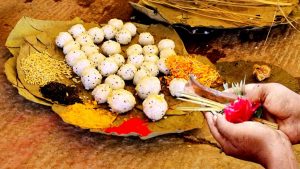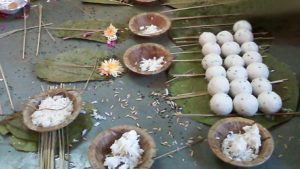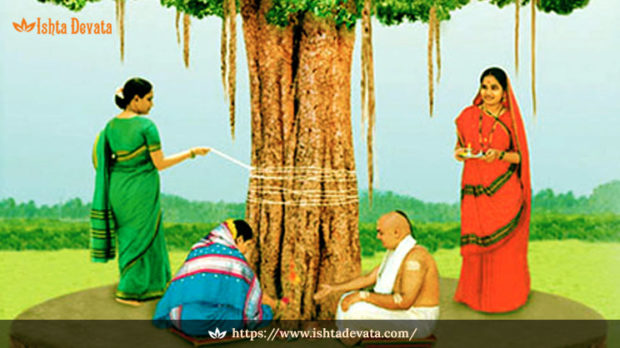Married Women across India peform this pooja and increase the life span of their Husband.
Vat Savitri Vrat (25th may 2017 and 8th June 2017)
Vat Savitri Vrat is one of the important Vrats (fasts) observed by married Hindu women on either the ‘Purina’ (full moon day) or ‘amavasya’ (no moon day) in the month of ‘Jyeshtha’ according to the Hindu calendar. The fasting usually commences on the ‘trayodashi’ (13th day of both the weaning and waxing phase) and ends on Purnima or Amavasya. Most Hindu festivals are celebrated on the same day, in accordance to both the Purnimanta as well as the Amanta lunar calendar. This Vat Savitri Vrat is the only exception. According to the Purnimanta calendar, this is observed on the ‘Jyeshtha Amavasya’ and is also widely celebrated as ‘Shani Jayanti’, while according to the Amanta calendar, this festival falls on the ‘Jyeshtha Purnima’ and is popularly called the ‘Vat Purnima Vrat’. This is the reason why married women in Gujarat, Maharashtra and other southern states celebrate the Vat Savitri Vrat 15 days after the celebrations by women in northern states. As per the Gregorian calendar, this holy Vrat falls between the months of May-June.
On the occasion of Vat Savitri Vrat, devotees usually worship the ‘Vat’ or Banyan tree. According to Hindu mythology, Banyan tree symbolises the ‘Trimurtis’ of Hinduism namely, Brahma, Vishnu and Shiva. The roots of the Banyan tree signifies Lord Brahma, the stem symbolises Lord Vishnu, while its leaves and branches represent Lord Shiva. The whole of Banyan tree is also interpreted as the much revered ‘Savitri’. Women in India generally observe a holy fast on this auspicious day to ensure the longevity of their husbands, thereby praying for a happy and prosperous life.
Legend associated with Vat Savitri Vrat
Long ago, there lived a noble king called Ashvapati, who was blessed with good health and abundant wealth. His only worry was that he didn’t have a child. The king was advised to undergo a fast (Vrat) in worship of Devi Savithri, who could grant him his wish to have a child. Accordingly, the king performed severe penance (tapsya) for almost 18 years. Moved by the king’s devotion, Devi Savitri blessed him with a girl child. The king named her ‘Savitri’ in honour of the deity. As time passed, Savithri grew into a beautiful woman and started searching an ideal groom for herself. She finally found her soul-mate in ‘Satyavan.
But unfortunately, Satyavan was meant to live for just an year more, as per his horoscope predictions. The determined Savitri married Sathyavan despite knowing his fate. They lived happily for an year until the day when Yama arrived to take away Satyavan with him. Savithri with her sheer intelligence and courage is said to have brought back Sathyavan from the clutches of Yama. Satyavan gave up his life under the Banyan tree and was again brought back to life on the same tree. From then on, married women followed the practice of offering prayers to the ‘Vat ‘(Bargad) tree on this Vrat festival. Savitri is also worshipped as a goddess on this day.
Know the Sathyavan Savitri story
Rituals during Vat Savitri Vrat
On the day of Vat Savitri Vrat, women usually wake up even before sunrise and bathe with ‘gingli’ oil (sesame seeds) and ‘amla’ (Indian gooseberry). They adorn new or fresh clothes and colourful bangles. They also apply the sacred vermillion on their foreheads, which indicates their married status. Their food for the entire day comprises of only Banyan roots that are consumed along with water. Many women observe this holy fast for three consecutive days, by eating just the Banyan roots for all three days.
The Vat tree is symbolised as Devi Savithri. Thus the married women worship the ‘Vat’ tree by tying a yellow or red coloured thread around the tree. They also offer water, flowers and rice to the tree. They then circumambulate the holy Vat tree, reciting few slokas and mantras.
All those who could not find a banyan tree nearby, can even make a portrait of the tree on a wood or plate using turmeric or sandalwood paste. Similar Pooja is performed to this Banyan image as well. Special food is prepared on the day of Vat Savitri Vrat. Once the puja gets over, these dishes are distributed among the near and dear ones. Women also seek the blessings of the elders in the family.
People usually undertake charity works on this auspicious day, which is considered highly rewarding. They donate money, food and clothes to the poor and needy.
Significance of Vat Savitri Vrat
The benefits of observing the holy Vat Savitri Vrat are mentioned in a number of Puranic scripts such as the ‘Bhavishyottar Purana’ and ‘Skanda Purana’. Married Indian women observe this Vat Savitri Vrat for the wellness and longevity of their husbands. They also seek the divine blessings to bring happiness and prosperity in their families.
Reach us to be a part of our whatsapp spiritual reminder group








